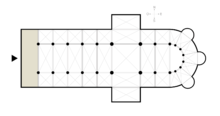Narthex
This article needs additional citations for verification. (August 2023) |

The narthex is an architectural element typical of early Christian and Byzantine basilicas and churches consisting of the entrance or vestibule, located at the west end of the nave, opposite the church's main altar.[1] Traditionally the narthex was a part of the church building, but was not considered part of the church proper.
In early Christian churches the narthex was often divided into two distinct parts: an esonarthex (inner narthex) between the west wall and the body of the church proper, separated from the nave and
By extension, the narthex can also denote a covered porch or entrance to a building.
Etymology
The original meaning of the
In English the narthex is now the porch outside the church at the west end; formerly it was a part of the church building itself,[5] albeit not considered part of the church proper, used as the place for
Purpose
The purpose of the narthex was to allow those not eligible for admittance into the general congregation (particularly
Later reforms removed the requirement to exclude people from services who were not full members of the congregation, which in some traditions obviated the narthex. Church architects continued, however, to build a room before the entrance of the nave. This room could be called an inside vestibule (if it is architecturally part of the nave structure) or a porch (if it is a distinct, external structure). Some traditions still call this area the narthex as it represents the point of entry into the church, even if everyone is admitted to the nave itself.
In the Eastern Orthodox Church, the esonarthex and exonarthex had, and still have, distinct liturgical functions. For instance, the procession at the Paschal Vigil will end up at the exonarthex for the reading of the Resurrection Gospel, while certain penitential services are traditionally chanted in the esonarthex.
In some Eastern Orthodox
The doorway leading from the narthex to the nave is sometimes referred to as the "Royal Doors",
On
In Armenia the local style of narthex is known as a gavit.
-
In the narthex of a small Orthodox church in Romania, looking through the doorway into theHoly Doors.
-
Side view of a narthex in anEastern Orthodox temple. In the center is an analogion at which the priest hears confessions, to the right of that is a silver baptismal font and vessels for dispensing holy water. The main hall is to the left (Pechersky Ascension Monastery, Nizhny Novgorod).
See also
- Antechamber
- Cathedral diagram
- Liturgical east and west
- Lobby
- Scarsella
- Westwork
References
- cardinal directions.
- ^ In other languages a different terminology can arise confusion. For example, in Italian the inner narthex is called endonartece and the outer narthex esonartece, as the inner narthex in English. Krautheimer (1986), passim
- ^ "narthex". Encyclopædia Britannica. Retrieved 23 April 2012.
- ^ LSJ narthex
- ^ William George Clark Peloponnesus: notes of study and travel 1858 Page 110 "One of the most perplexing words in etymology and application is the word narthex. In modern times it can be applied to the porch outside the church at the west end; in old days it was given to a part of the church itself, ..."
- ^ The national encyclopædia. ed. John H F. Brabner – 1884 "This space was the narthex or " scourge," and was for the use of penitents. The name was also extended to the outer court "
- Holy Doors.
- ^ See Ezekiel 44:1–3)
Further reading
- ISBN 88-06-59261-0.
External links
 Media related to Narthexes at Wikimedia Commons
Media related to Narthexes at Wikimedia Commons


